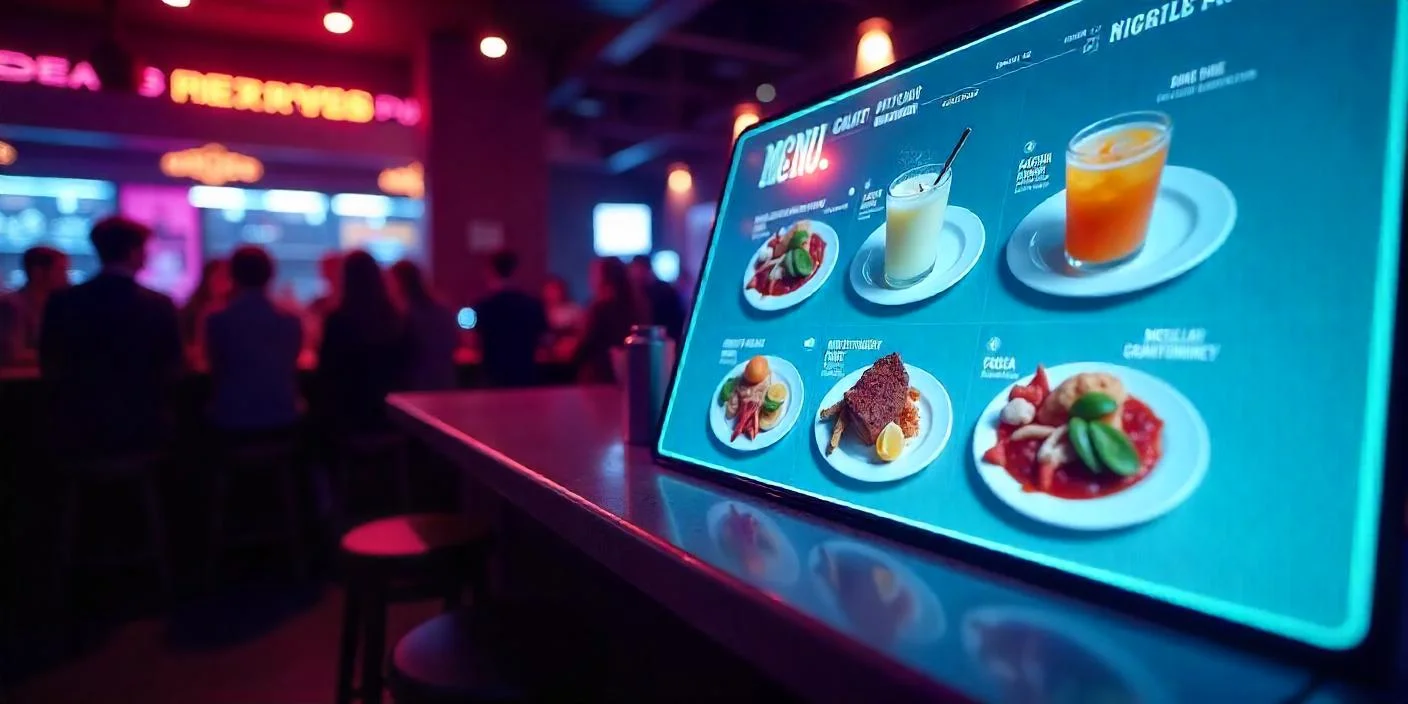Beyond the Static Screen
Consider the last time you passed by a fixed poster outside a store or in a lobby. Most people don’t pay much attention to it. Now envision that same space with an animated, interactive screen that beckons you to scroll through a menu, zoom in on an item, or find directions. What was once invisible becomes engaging.
That is the promise of touch screen digital signage—it turns one-way communication into two-way communication. Businesses can invite customers to interact, discover, and explore instead of passively presenting content. Interactive digital signage is no longer a luxury in a world where engagement is equated with attention. It is quickly becoming a requirement.
Ready to move beyond static signs? See how Nento’s interactive solutions can captivate your audience. Learn More About Nento
What is Touch Screen Digital Signage?
Definition & Core Components
At its core, touch screen digital signage is a combination of hardware (like a touch screen TV monitor, kiosk, or large-format display) and software (digital signage touch screen software) that lets users interact with content. Viewers can tap, scroll, and explore information instead of passively watching a video loop or static slides.
Hardware Options
Interactive systems can be applied in business in the following ways:
- Touchscreen TV monitors in retail stores for product discovery.
- Wayfinding and check-in at digital signage touch screen kiosks in airports, hotels, or corporate lobbies.
- Digital touch screen displays are exhibited in museums or other places of interactive learning.
Software Essentials
The touch screen digital signage software is installed behind all the screens. This software drives the content, updates it, makes it interactive, and tracks the usage. Even the best hardware is useless without it.
Understanding the components is the first step. Let Nento guide you through selecting the perfect hardware and software bundle for your needs. Explore Nento Hardware Partners
Why Your Business Needs Interactive Digital Signage
Engagement & Customer Experience
Customers today expect immersive experiences. Interactive touch screen digital signage lets them browse menus, explore virtual catalogs, or filter information to their preferences. This practical experience keeps them more active, as well as making the interactions with the brand memorable.
Operational Efficiency & Data Insights
Interactive kiosks save on repetitive staff queries, be they directions in a hospital or menu queries in a restaurant. Meanwhile, they gather useful information on customer behavior. An example is which menu item is tapped the most? What types of products are of interest? Such insights are used to optimize the content and operations of businesses.
Success Snippet: A Nento retail client reported a 40% drop in staff queries after deploying interactive kiosks for product lookups.
Brand Positioning & Modern Perception
Adopting interactive digital signage displays is an indicator that your brand is innovative and customer-centric. In most companies, a digital screen signage system that replaces the stationary poster enhances professionalism and improves service delivery.
Imagine reducing front-desk queries by 50% or doubling product discovery in-store. That’s the kind of ROI businesses are already seeing with Nento. Read Our Customer Success Stories
Powerful Applications Across Industries
Mini Story: A mid-sized café used an interactive menu board to display allergen filters. Within three months, they saw a 17% increase in customer satisfaction scores.
Retail & E-Commerce
Touchscreen retail displays are used by retailers for product lookbooks, inventory checks, and endless aisle browsing. Others go further to use virtual fitting rooms where customers can virtually try out the products and then purchase them.
Restaurants & Hospitality
Digital signage touch screen kiosks have interactive menus that allow customers to filter by allergen, see pictures, and even place orders. Hotels have kiosks to do self-service check-ins, concierge services, and local recommendations.
Corporate Offices & Lobbies
Digital screen signage systems simplify visitor management, offer wayfinding interactivity, and keep the staff updated using KPI dashboards. This modernizes the communication and minimizes the use of reception personnel.
Education, Healthcare & Public Spaces
Universities are implementing the use of digital signage on maps, directories, and schedules. They are used by hospitals to reduce wait-time frustrations through offering instant navigation. The interactive digital signage displays transform museum exhibits into interactive learning experiences.
Inspired by these use cases? Our experts at Nento specialize in creating custom solutions tailored to your industry. Get a Custom Solution Proposal
The Brains Behind the Operation: Choosing Your Touch Screen Digital Signage Software
Pro Tip: Don’t just look for flashy features—reliable digital signage touch screen software should give you uptime guarantees and easy remote management.
Why Software is the Brains of the System
The power of a display is limited to the power of the software running it. The actual worth of digital signage touch screen software is the fact that the software is able to control the content, provide real-time information, and give the user something to interact with.
Features That Matter
In considering solutions, look for:
- Intuitive CMS: Drag and drop content creation.
- Interactive Builders: Create maps, buttons, and galleries without code.
- Real-Time Integrations: Pull live news, weather, or social feeds into your displays.
- Scalability: Be it one screen or one thousand, control it all through a single dashboard.
- Analytics & Reporting: Test the user behavior and the campaign performance.
Why juggle multiple platforms? Experience the simplicity of Nento’s all-in-one software with a free trial. Start Your Free Trial
Quick Start Guide to Implementation
Step 1: Define Your Goals
Do you focus on customer engagement, sales, or operational efficiency? A good objective is a motivating one.
Step 2: Choose the Right Hardware
In touch screen TV monitors in retail and in public areas and ruggedized kiosks, hardware should be appropriate.
Step 3: Select Your Software
This is where Nento comes in; our interactive digital signage display software runs all the menus, maps, and more.
Step 4: Design Engaging Content
Make interactions easy, intuitive, and attractive. The best digital signage touch screen kiosks are the ones that have instant value.
Step 5: Deploy, Monitor & Optimize
Go live, then measure results. Optimize layouts, content, or functionality by data insights.
Implementation doesn’t have to be complex. From planning to support, Nento is with you every step of the way. Speak with an Implementation Specialist

FAQs: Your Questions Answered
What’s the difference between a regular TV and a touchscreen digital signage display?
A consumer-grade digital touch screen display is designed to be used at home, whereas a commercial-grade version features a brighter, more durable display built for all-day use.
Is interactive signage difficult to manage?
Not with modern software. Nento’s platform lets anyone update and publish content through an online dashboard.
Can I use touch screen signage for wayfinding?
Absolutely. Digital signage touch screen kiosks can be used in campuses, malls, and hospitals for directories, maps, and navigation.
Are public touch screens durable enough for heavy use?
Yes. The typical commercial models have hardened glass, scratch resistance, and enclosures to resist a high-traffic environment.
Peace of Mind: Commercial digital touch screen displays are tested for over 50,000 touches to ensure longevity in high-traffic areas.
What type of content works best on interactive screens?
The most effective content is visual, interactive, and instantly useful—catalogs, quizzes, self-service menus, and interactive maps.
Need help designing your content? Nento’s creative team can build stunning, user-friendly interactive experiences for you. Learn More
Stop Planning, Start Engaging
With Nento, you get the complete ecosystem:
- Commercial-grade touch screen retail displays and kiosks.
- Powerful, intuitive digital signage touch screen software.
- Expert planning, deployment, and ongoing support.
Don’t just imagine interactive customer experiences—make them real.







